NOTE: Click here for issue one.
—
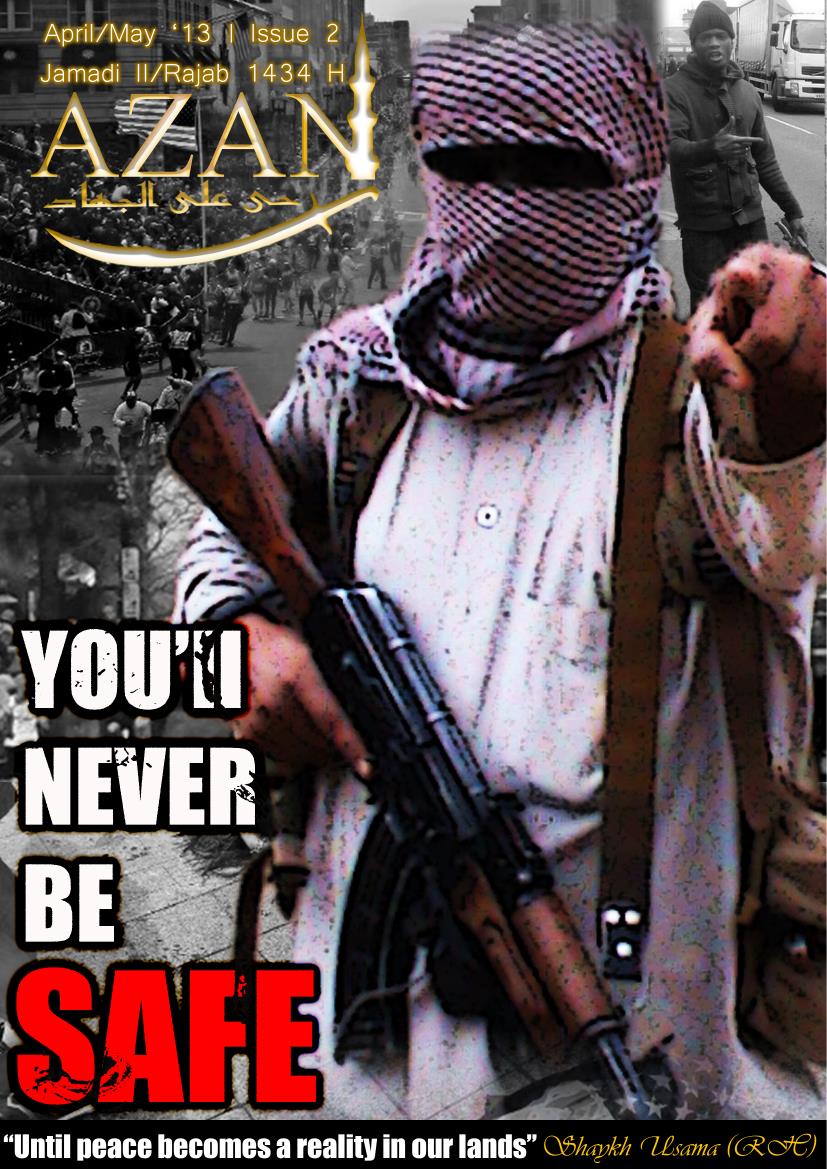
Click the following link for a safe PDF copy: Azan Magazine Issue #2
_________
Month: June 2013
New statement from the Islamic Emirate of Afghanistan’s Qārī’ Muḥammad Yusuf Aḥmadī: "Remarks Regarding Visits to the Islamic Republic of Iran by Delegations of the Islamic Emirate"

The Islamic Emirate confirms reports published by Fars news agency regarding visit by a delegation of Islamic Emirate of Afghanistan to the Islamic Republic of Iran.
A delegation headed by the chief of political office of Islamic Emirate of Afghanistan went on a three day visit to the capital of Islamic Republic of Iran, Tehran, a while ago where issues of mutual interests were discussed by both sides after which the delegation returned.
Similarly, high ranking officials of Islamic Emirate also made another visit in the recent past to the Islamic Republic of Iran after a formal invitation by the said country where the delegation of Islamic Emirate participated in an international Islamic conference which was convened in the capital Tehran.
The delegation delivered a speech in which it furnished all the participants with general information about the legitimate demands of Islamic Emirate and made clear its policy concerning key Afghan and international issues.
In this visit, which took place due to a formal invitation by the government of Iran, the delegation of Islamic Emirate made heard the voices and demands of its people and Mujahideen to the emissaries of various countries, gave information about the current ongoing situation and also held positive talks with high ranking officials of Islamic Republic of Iran about multiple issues especially about the subject of Afghan refugees who are living inside Iran. They asked the Iranian government to give special consideration to solving the problems faced by these refugees and to prevent sour incidents from occurring.
The Islamic Emirate has also previously made heard its policy to the world by participating in conferences in Japan and France, the outcomes of which have been positive.
We should mention that the Islamic Emirate has always strived to keep relations with the neighboring countries and countries of the world based upon mutual respect and it shall continue doing so.
Spokesman of Islamic Emirate of Afghanistan
Qari Muhammad Yousuf Ahmadi
24/07/1434
13/03/1392 03/06/2013
___________
Ibn Taymīyyah Center for Media presents a new article from Abū Sulaymān al-Filisṭīnī: "Strength of the Field Officer and Repeating the Experience of 'Ḥizb Allah' in the Protection of the Jews"

Click the following link for a safe PDF copy: Abū Sulaymān al-Filisṭīnī — “Strength of the Field Officer and Repeating the Experience of ‘Ḥizb Allah’ in the Protection of the Jews”
__________
To inquire about a translation for this article for a fee email: [email protected]
Ṣawt al-Islām presents a new video message from Ḥizb al-Islāmī al-Turkistānī [Turkistan Islamic Party]: “Lovers of Paradise #9"
al-Malāḥim Media presents a new video message from al-Qā’idah in the Arabian Peninsula: “Interview with the Deputy Consul of the Saudi’s #2"
UPDATE 6/16/13 11:34 AM: Here is an English translation of the below Arabic video message and transcription:

____________
—
UPDATE 6/6/13 7:42 PM: Here is an Arabic transcription of the below video message:
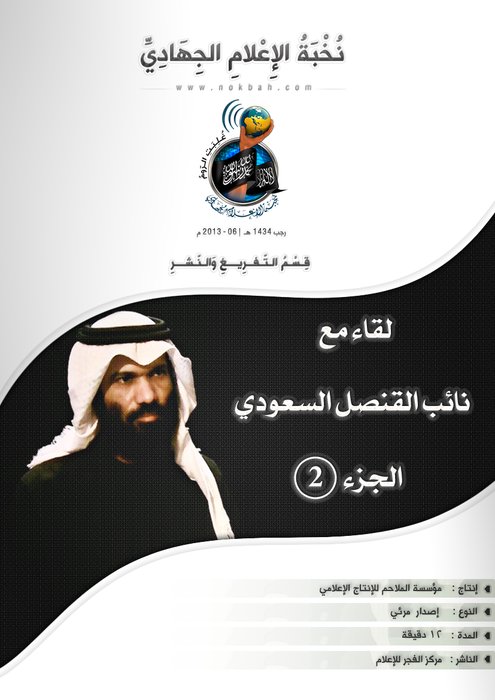
Click the following link for a safe PDF copy: al-Qā’idah in the Arabian Peninsula — “Interview with the Deputy Consul of the Saudi’s #2″ (Ar)
__________
—
NOTE: Click here for part one of this video series.
—

__________
New statement from Anṣār al-Islām: "To the Sunnī People in Iraq"

Click the following link for a safe PDF copy: Anṣār al-Islām — “To the Sunnī People in Iraq”
__________
To inquire about a translation for this statement for a fee email: [email protected]
Check out my new joint study with Flashpoint Partners: "Convoy of Martyrs in the Levant: A Joint Study Charting the Evolving Role of Sunni Foreign Fighters in the Armed Uprising Against the Assad Regime in Syria"


Click the following link for a safe PDF copy: Convoy of Martyrs in the Levant- A Joint Study Charting the Evolving Role of Sunni Foreign Fighters in the Armed Uprising Against the Assad Regime in Syria
Hizballah Cavalcade: Kata’ib Sayyid al-Shuhada: Another Supplier of Iraqi Shia Fighters in Syria
NOTE: For prior parts in the Hizballah Cavalcade series you can view an archive of it all here.
—
Kata’ib Sayyid al-Shuhada: Another Supplier of Iraqi Shia Fighters in Syria
By Phillip Smyth
Click here for a PDF version of this post
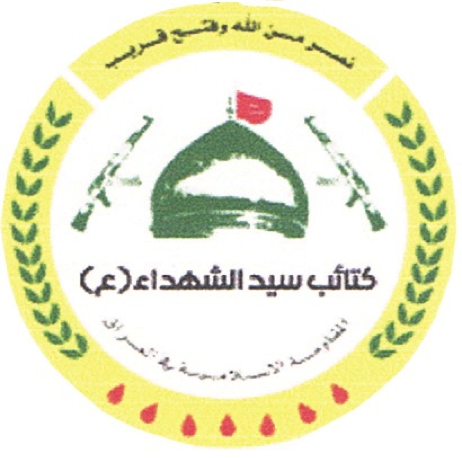
Figure 1: Kata’ib Sayyid al-Shuhada’s symbol.
Following funerals for some of its members killed fighting in Syria, The Kata’ib Sayyid al-Shuhada (The Battalion of the Sayyid’s Martyrs or KSS) has quietly established itself as an Iraqi Shia militia force contributing combatants to the battlefront in southern Damascus. At present, the KSS’s main raison d’être appears to be as a source for Iraqi Shia fighters who can be used to “Defend the Zaynab Shrine”, a major Shia Islamic site in Syria.
The first reports of KSS’s existence occurred on April 14, 2013. In one press report, it was stated that KSS initially went by the names of Kata’ib Karbala (the Karbala Battalions) and later as Kata’ib Abu Fadl al-Abbas.[1] Interestingly, a group which had targeted American and Coalition forces in Iraq was and Iranian-backed “Special group” called Kata’ib Abu Fadl al-Abbas.[2] Adding further significance to the KSS’s earlier names and its links to Syria; KSS sends its fighters to Syria where they act as an intrinsic part of the Syrian-based Liwa’a Abu Fadl al-Abbas (LAFA).
It was reported that the KSS was formed due to splits within the Iranian-created and backed Kata’ib Hizballah.[3] These contentions were initially based on nameless sources and were reported by a small number of Iraqi Arabic-language publications. It was also claimed that Abu Mustafa Sheibani (Hamid al-Sheibani), a pro-Iranian militia leader, who had been involved with the creation of many so-called “Special Groups” (including Asa’ib Ahl al-Haq and Kata’ib Hizballah) was KSS’s leader.[4] According to a Washington Institute for Near East Policy report, Sheibani “holds both Iranian and Iraqi citizenship” and when operating in Iraq, concentrated on the, “distribution of explosively formed penetrator (EFP) roadside bombs”.[5]
Based on the KSS’s few public appearances and its activity in Syria, it is likely the organization has a steady source of funding. Said funding allows the group to hold attention grabbing funerals and to put on airs of professionalism and organization. Nevertheless, based on Iraqi media, forums, and other social media sources, the size of the group’s membership, leadership, recruitment activities, and amounts of money it may receive remain unknown or unconfirmed.
Mirroring the activities of other Lebanese and Iraqi pro-Iranian groups, such as Kata’ib Hizballah, Asa’ib Ahl al-Haq, and Hizballah, the KSS sent a number of fighters to serve in the ranks of the Damascus-based Liwa’a Abu Fadl al-Abbas. When these fighters were killed, LAFA was often the initial or only group which would claim them as members. Only when Iraqi family members of dead fighters were interviewed, was it revealed their deceased relatives were also members of KSS.[6]
Pointing to direct Iranian support for KSS, the bodies of fighters who belonged to the organization have, on all occasions involving a funeral, been returned to Iraq via Iran. On May 6, 2013, the funeral for Diya Issawi included claims he belonged to KSS and that his body was returned to Iraq from Iran, through Basra.[7] Later that month, on May 17, 2013, two more funerals were held for Iraqis killed in Syria. The first, for Hassan Ali Farhud, was held in Sadr City, a Shia section of Baghdad.[8] The second funeral, for Muhammed Aboud al-Maliki, was held in Basra. Paralleling the return of Issawi’s body, Farhud and Maliki’s bodies were delivered through Iran. (Note: Partial profiles for Farhud, Issawi, and Maliki, were provided on Hizballah Cavalcade’s “Roundup of Iraqis Killed in Syria, Part 2”).
During funerals for its members, the KSS has fielded guards dressed in matching camouflage fatigues and a full color guard holding a mixture of KSS and Iraqi flags. Coffins for the dead are usually covered with Iraqi national (often painted onto the casket) and KSS flags. In most cases, the funeral processions resemble other funerals held for members belonging to Kata’ib Hizballah and Asa’ib Ahl al-Haq.

Figure 2: KSS statement released on May 8, 2013.
Following the funeral for Issawi, KSS declared its goals in a press statement issued by its media office. The group stated its aims included the protection of “shrines across the globe”, the preservation of “Iraqi unity”, and an end to sectarian conflict. It was claimed by KSS that its enemies were “Sowing [Islamic sectarian] discord” due to their “suspicious motives”. The group also mentioned that Israel is “Cancerous”, the U.S. occupation of Iraq was a symbol of “Arrogance”, and called for Jerusalem to be liberated.[9] For all intents and purposes, KSS repeated many of the main talking points presented by Lebanese Hizballah and Iran, albeit with an Iraqi spin.[10]
Despite the group’s statement claiming it was against sectarianism, some Iraqi forums reported the group had threatened to kidnap Iraqi Sunni Muslims.[11] Nevertheless, the KSS’s military activities appear to be limited to engagements in Syria.
WARNING: GRAPHIC IMAGES
Videos featuring KSS members have also been a relative rarity. Save for the posting of funeral videos made for fallen KSS members, only one video—posted on May 28, 2013—claims to be a KSS-specific combat video. Released on YouTube, the film purports to show KSS members (likely attached to LAFA) operating in Syria and displaying the dead bodies of what the video refers to as, “Wahhabi Free Syrian Army mercenaries”. Further linking KSS to LAFA, the film was set to an Iraqi-made pro-Liwa’a Abu Fadl al-Abbas song, which first appeared online in early-2013. KSS members present in the film can also be seen wearing fatigues which are commonly worn by LAFA members.
When compared to LAFA and Lebanese Hizballah, social media and forum presence for Kata’ib Sayyid al-Shuhada has been sparse. What appeared to be a main Facebook “page” was created for the group on April 19, 2013.[12] However, the page conveyed little information and most posted material came on the day it was created or on April 26, 2013. The majority of the postings were of edited photos (mainly of the Zaynab Shrine) which could also be found on most pro-LAFA and pro-Hizballah websites. It is unknown whether the page was sanctioned by the group’s leadership. Membership for the page stands at fewer than 200. Additionally, a preponderance of those who “liked” the page lived in Baghdad, Iraq.
Facebook “Groups” have also been created for Kata’ib Sayyid al-Shuhada. Most of these groups have less than 300 members and tend to contain more information about the organization. Photos made specifically for KSS are present on these devoted KSS group pages. However, they tend to utilize imagery which has been used previously by LAFA. In general, KSS’s images are at times more amateurish than with other Shia militias operating in Syria.
The KSS’s dead maintain positions of prominence in KSS Facebook groups. On rare occasions, photos of live KSS members serving with LAFA have their faces blurred. One KSS group page even featured photos of what were presumably KSS fighters arriving by bus to the frontlines in Syria. Based on the captions provided for these and other photographs, it appears that KSS fighters may primarily originate from Basra, Iraq. Incidentally, the many mentions of Basra would also coincide with two of the three funerals for killed KSS members, since they also occurred in Basra.
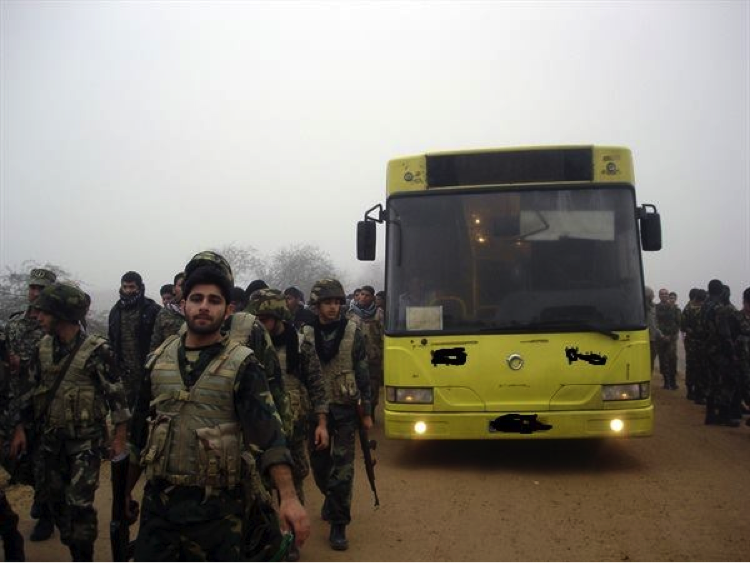
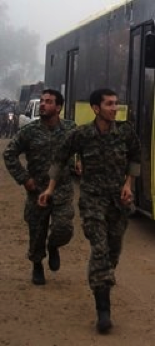
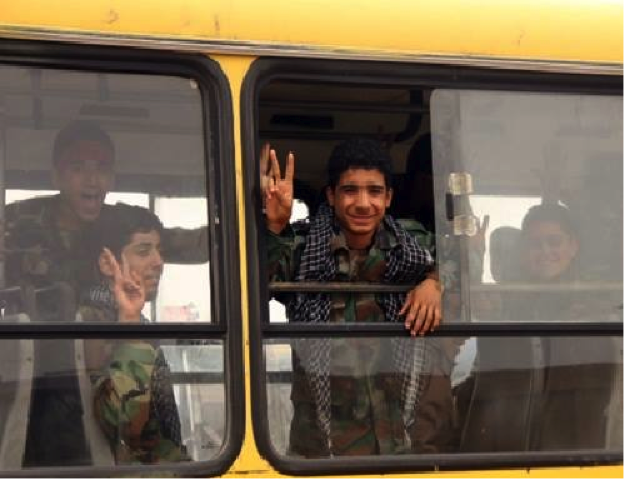
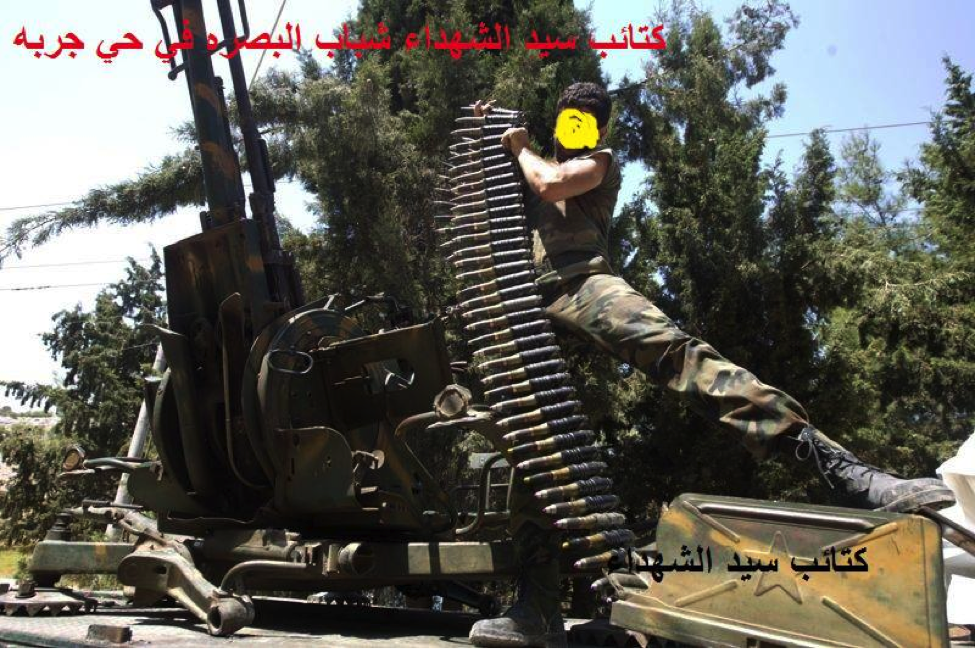
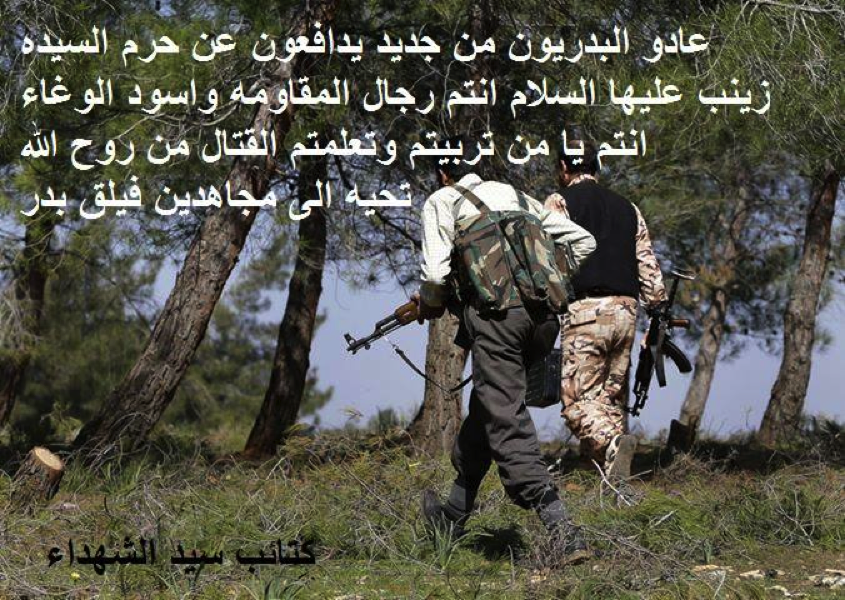
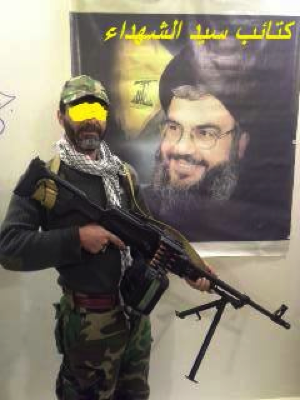
Figure 3: A KSS member is seen posing with a poster for Lebanese Hizballah leader Sayyid Hassan Nasrallah.
Underpinning the KSS’s Zaynab Shrine-centric role, their official symbol has a number of key images which emphasize Shi’ism, the Zaynab Shrine, and militarism. First, a stylized and green-colored image of Damascus’s Zaynab Shrine’s dome stands in the center with a red banner flying from the top. The raising of the red banner—symbolizing martyrdom and sacrifice—on top of the Zaynab Shrine has been used to great propagandistic effect by Shia groups such as Lebanese Hizballah and LAFA. The dome is flanked on two sides with images of AK-47 rifles. Around the dome on a roundel is a laurel wreath. At the bottom of the roundel are stylized blood drops. The blood drops may serve as a
Hizballah Cavalcade: Roundup of Iraqis Killed in Syria, Part 3
NOTE: For prior parts in the Hizballah Cavalcade series you can view an archive of it all here.
—
Roundup of Iraqis Killed in Syria, Part 3
By Phillip Smyth
Click here for a PDF version of this post
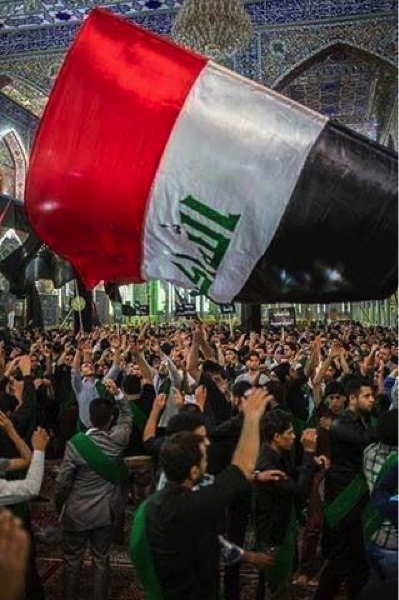
Collecting information for profiles of Iraqi Shia killed fighting in Syria became more complicated following further acknowledgements by Hizballah’s leadership of their involvement in Syria.[1] Concurrently, Liwa’a Abu Fadl al-Abbas (LAFA), the Damascus-based pro-Assad Shia militia which includes a large number of Iraqi Shia, also became more open with their recognition of Lebanese Hizballah members killed serving with the group. Thus, announcements-of-death for Iraqi LAFA members were often mixed with large numbers of Lebanese Hizballah martyrdom announcements.
Martyrdom declarations for Iraqi Shia have also continued to follow a format where the majority of dead individuals have only one or two photographs of themselves released. Often, the photographs of these dead fighters are found on an official martyrdom poster produced by the Iraqi group to which these fighters originally belonged. On rare occasions, killed Iraqi Shia will have many photographs of them or their funerals displayed online. One Facebook-hosted funeral photo album, released for Al-Sa’id Mutheneh ‘Abees Khafeef, numbered around 80 photographs.
It has become increasingly clear that the majority of Iraqi Shia killed fighting in Syria have belonged to the Iranian created and backed, Asa’ib Ahl al-Haq. Asa’ib Ahl al-Haq has not announced the loss of any of their members via their website. Instead, the group has relied on quasi-official and pro-Liwa’a Abu Fadl al-Abbas Facebook pages to report its dead. At times, announcements for killed Asa’ib Ahl al-Haq members have first emerged on Facebook pages and forums (including official forums) for Lebanese Hizballah. This likely demonstrates another deep link the group has with Lebanese Hizballah.[2]
Kata’ib Hizballah, another Iraqi organization created by the Iranians, had announced that it lost a number of members in Syria in mid-March-mid-April. However, this organization has not issued any new statements regarding further losses.[3]
This post only includes five dead from a period starting on May 18, 2013 and ending on May 31, 2013. One killed Iraqi Shia fighter reported dead on May 9th, was also confirmed. Despite the lower number of Iraqi Shia declared as, “killed fighting in Syria”; there is a strong possibility reported numbers of Iraqi Shia killed in Syria may rise in the coming weeks.
Nine pro-Hizballah, pro-Liwa’a Abu Fadl al-Abbas, Iraqi Shia, and pro-Assad Facebook pages (all Shia oriented) were utilized in the collection of information for this list. Two pro-Hizballah forums—one official and one quasi-official—were also employed for confirmation purposes.
__
Name: Al-Sa’id Mutheneh ‘Abees Khafeef
Affiliated With: Asa’ib Ahl al-Haq/Liwa’a Abu Fadl al-Abbas
Death Announced: May 18, 2013 (via Facebook). The funeral was held on May 18, 2013 in Baghdad.
Notes: Khafeef’s funeral had an entire photo album on Facebook devoted to it. Additionally a video of the funeral was also posted to YouTube.
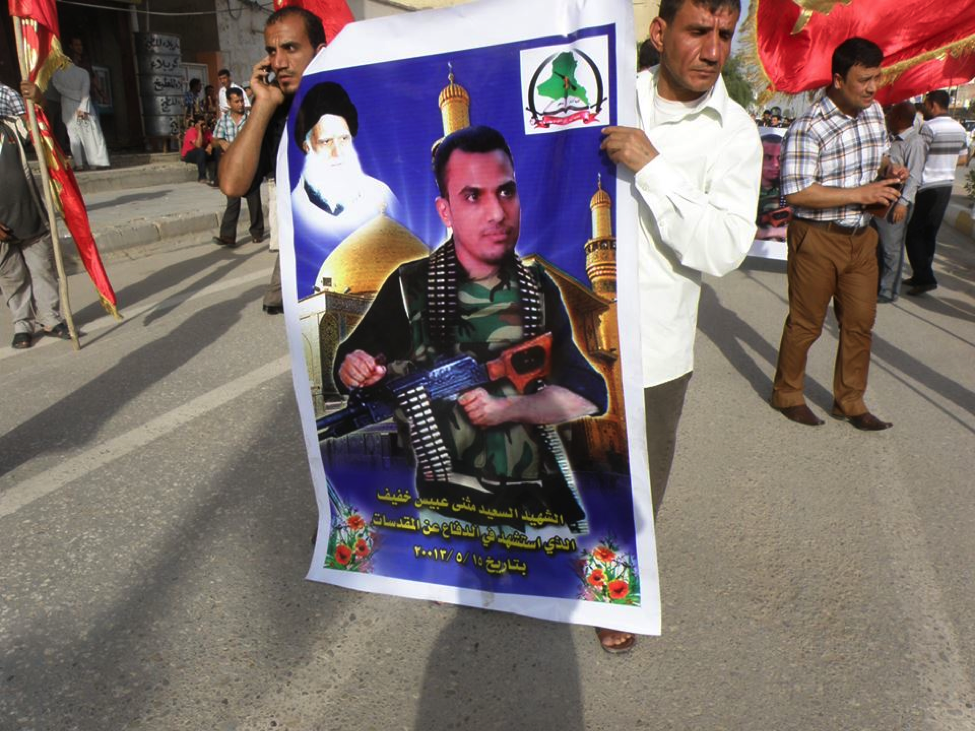
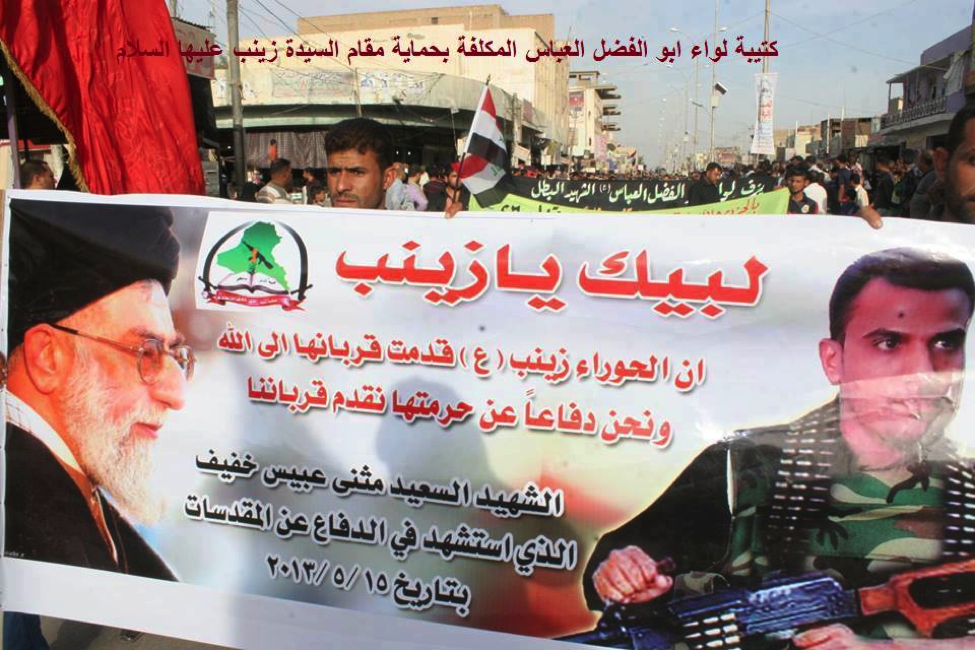
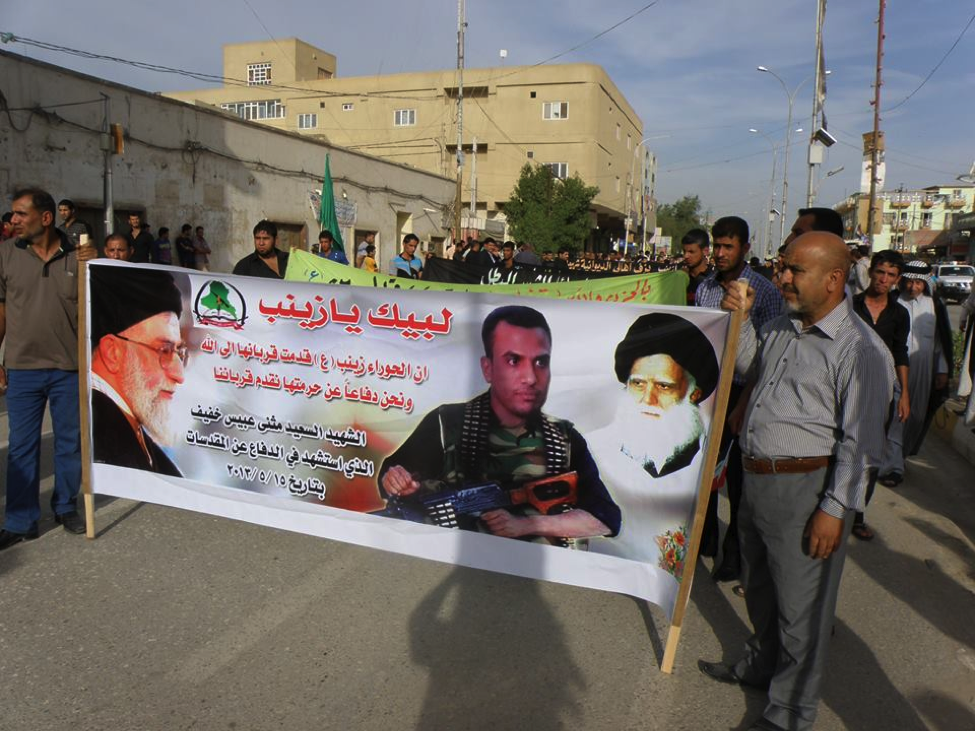
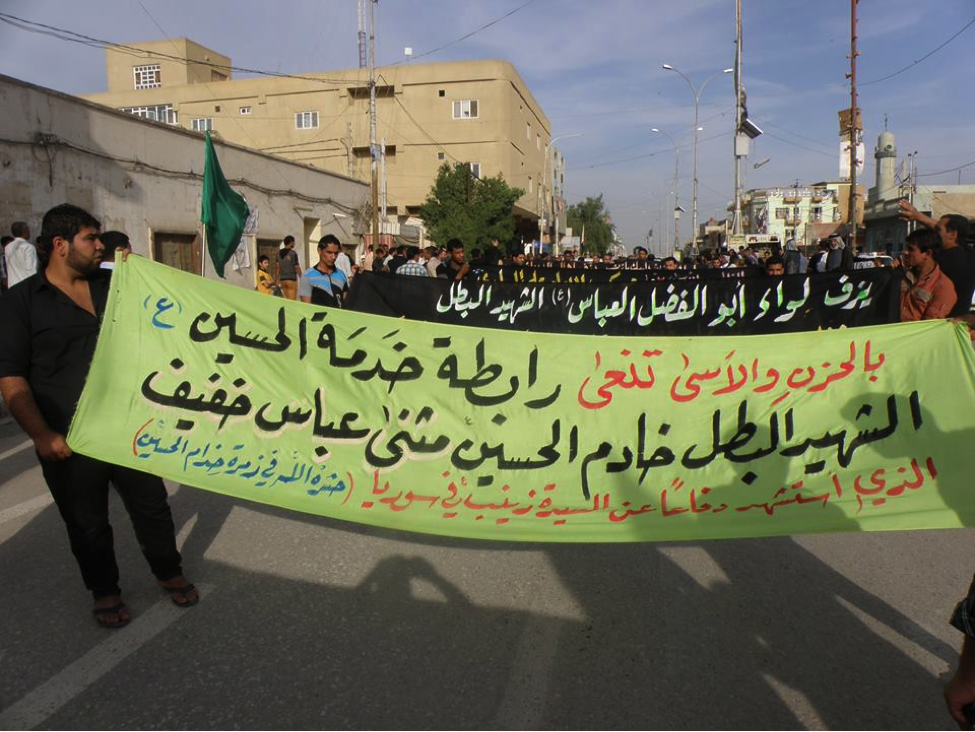
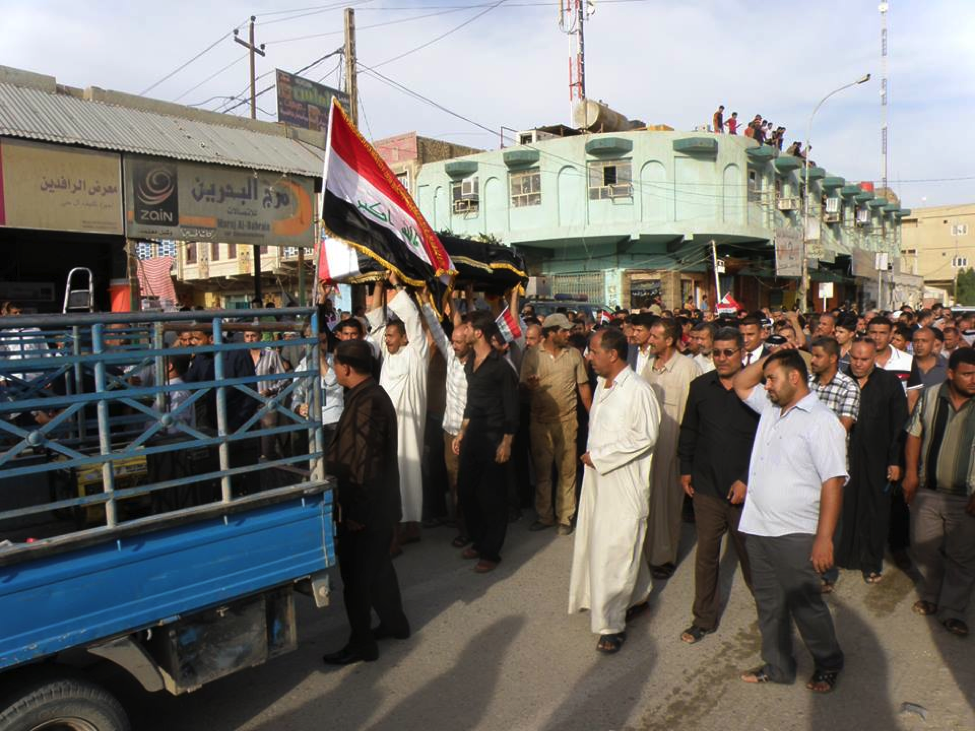
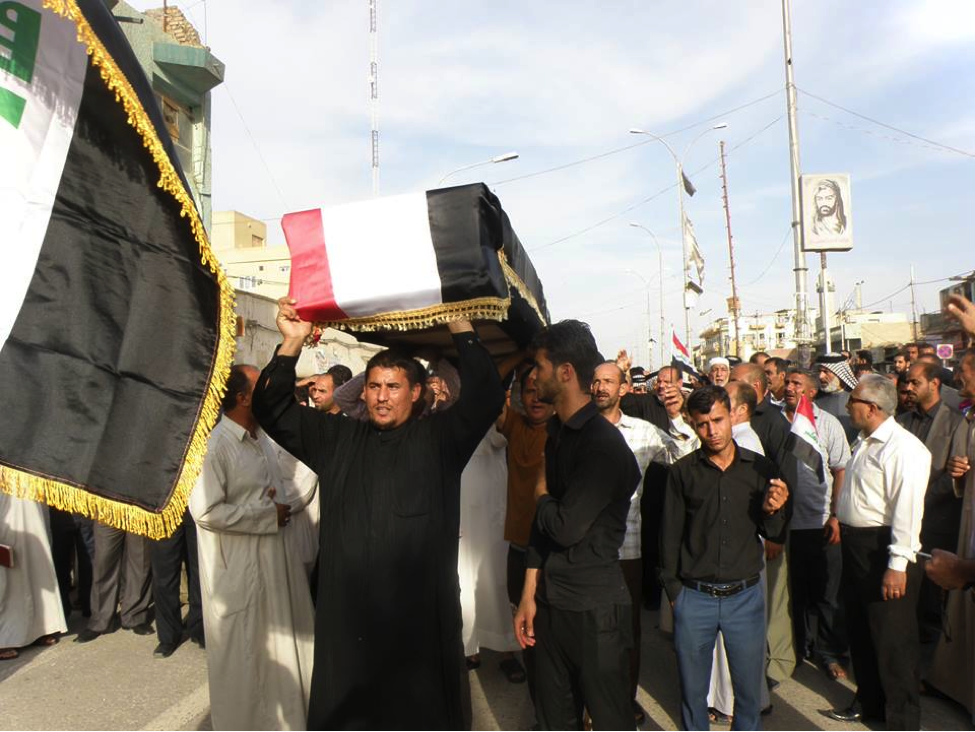
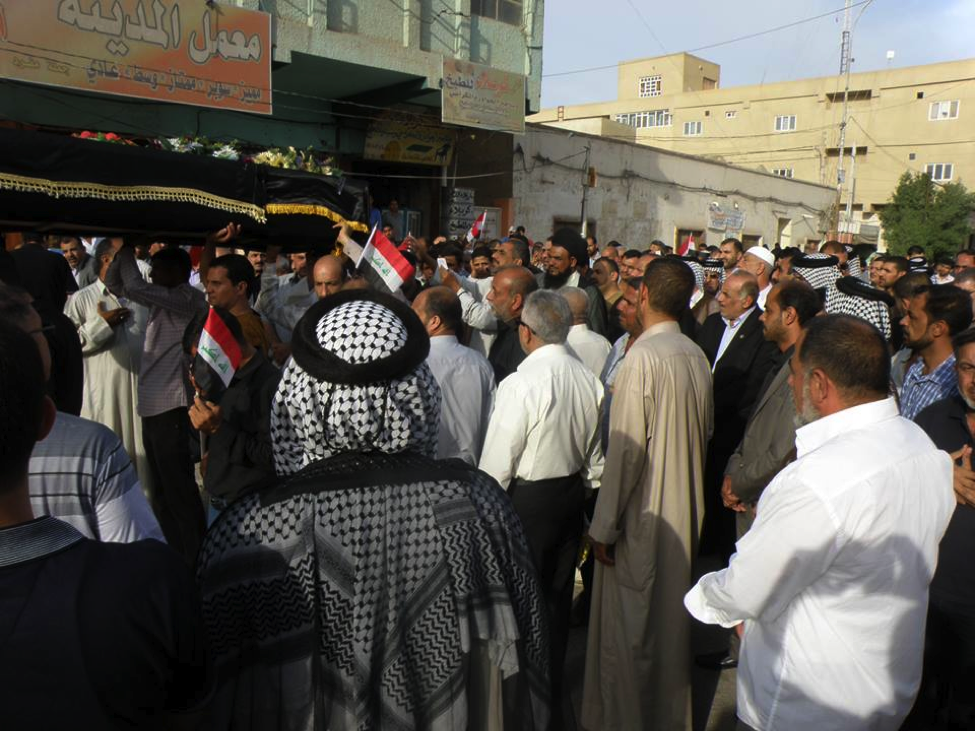
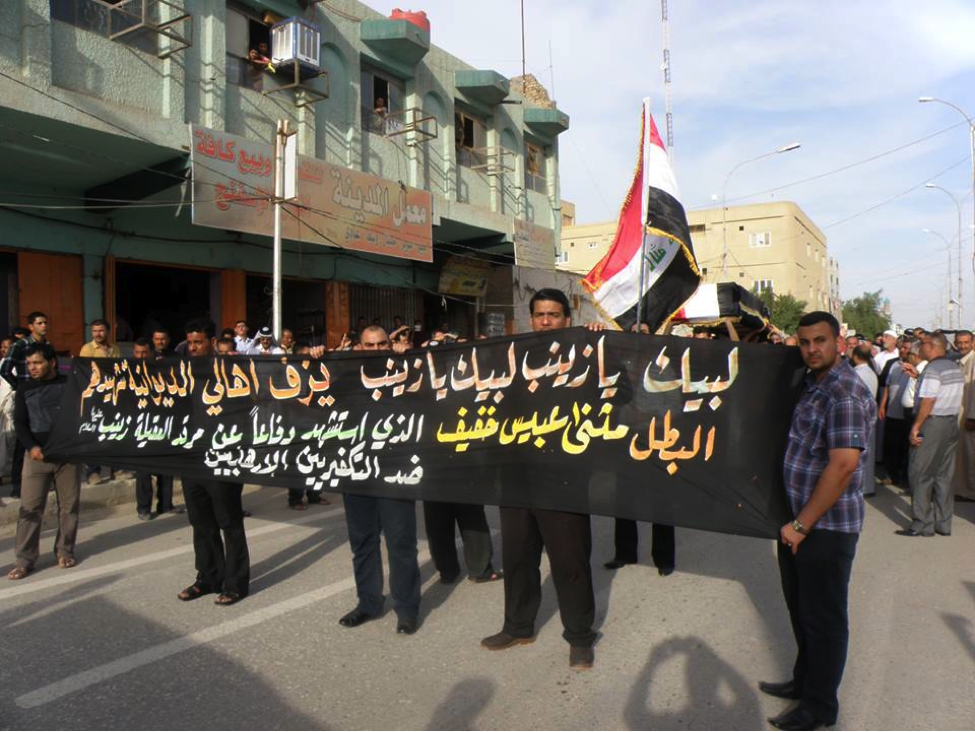

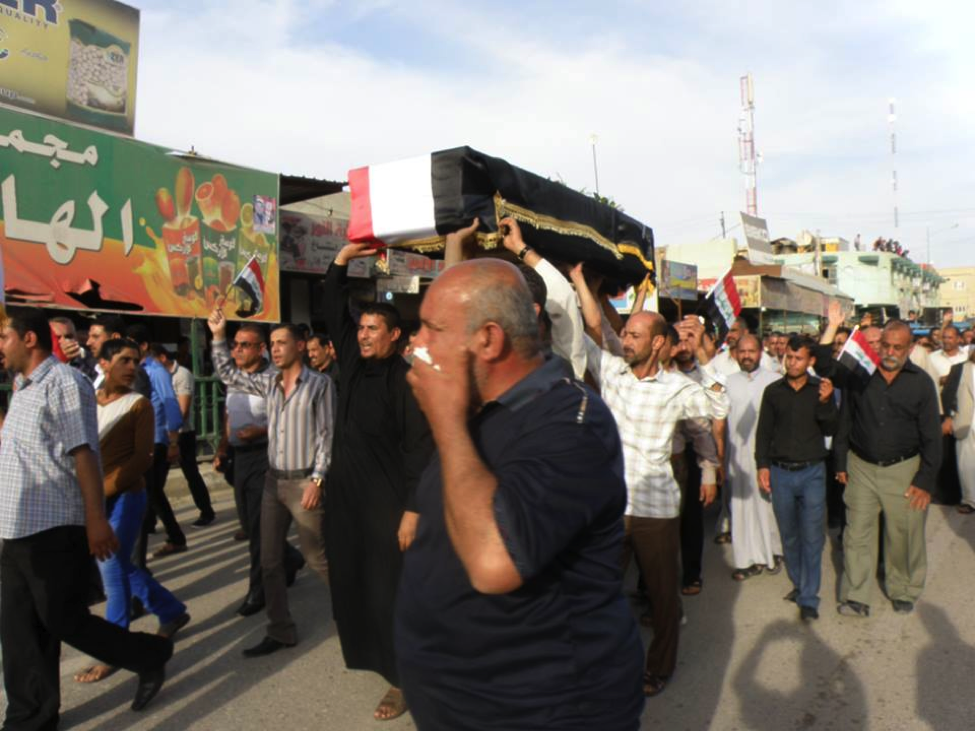
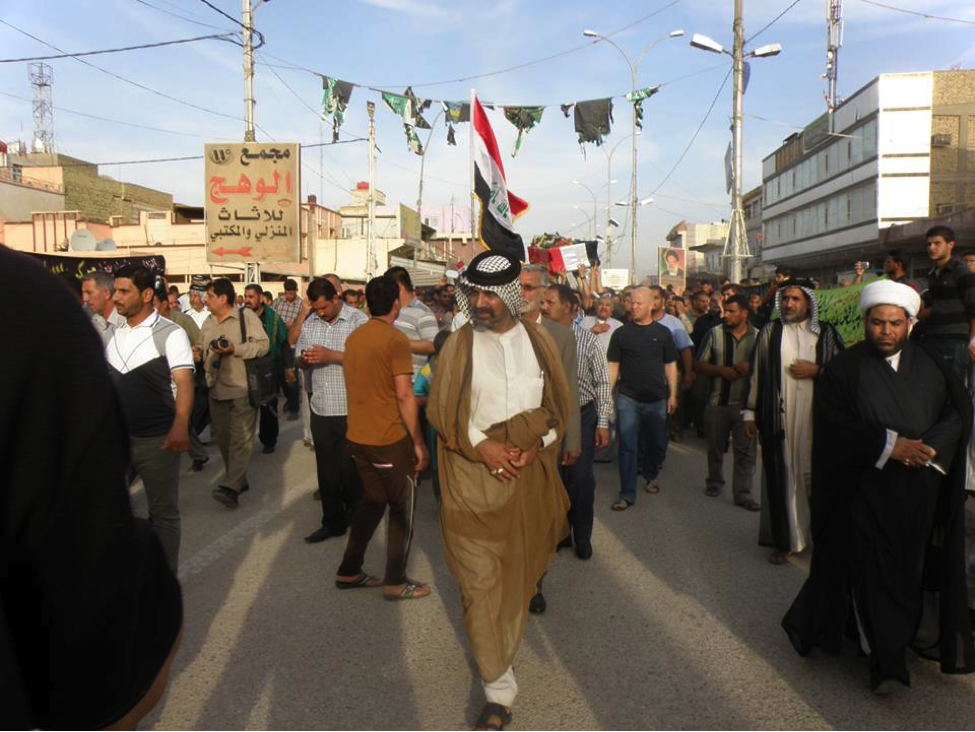
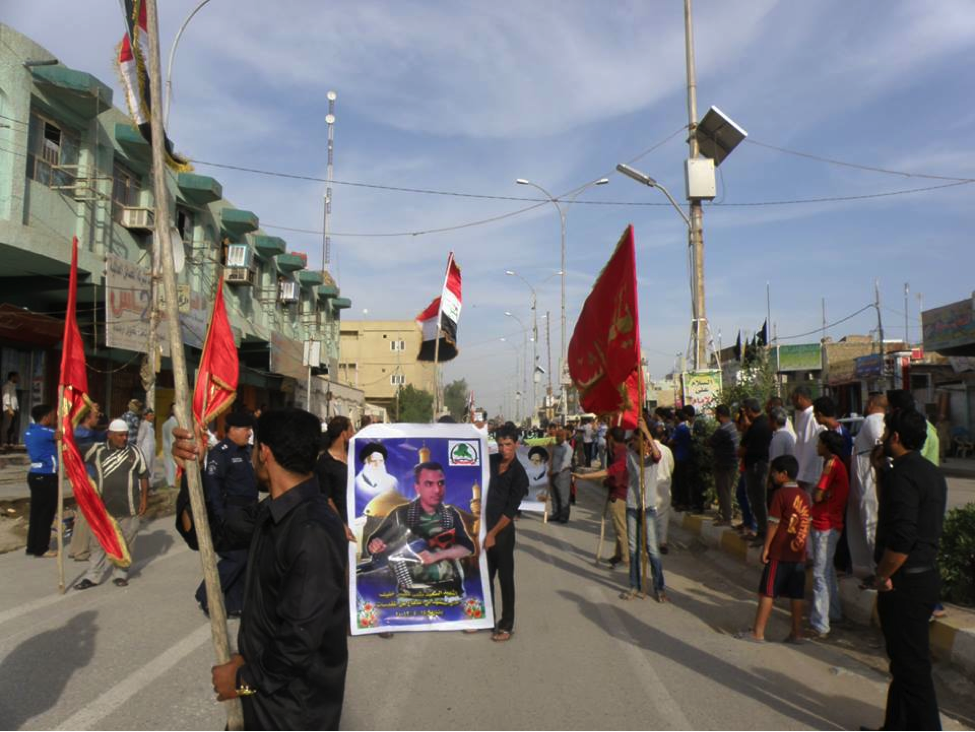

Name: Hamid Abu ‘Amran al-Bahadali (A.K.A. Abu ‘Amran/’Umran)
Affiliated With: Liwa’a Abu Fadl al-Abbas/Asa’ib Ahl al-Haq
Death Announced: May 26, 2013 (two Facebook pages claimed his death was announced on May 25th)
Notes: Bahadali was initially only claimed by Liwa’a Abu Fadl al-Abbas as a member. However, on May 28th it was announced on a prominent pro-Hizballah/pro-LAFA Facebook page that he also belonged to Asa’ib Ahl al-Haq. His funeral was reportedly held in Baghdad.
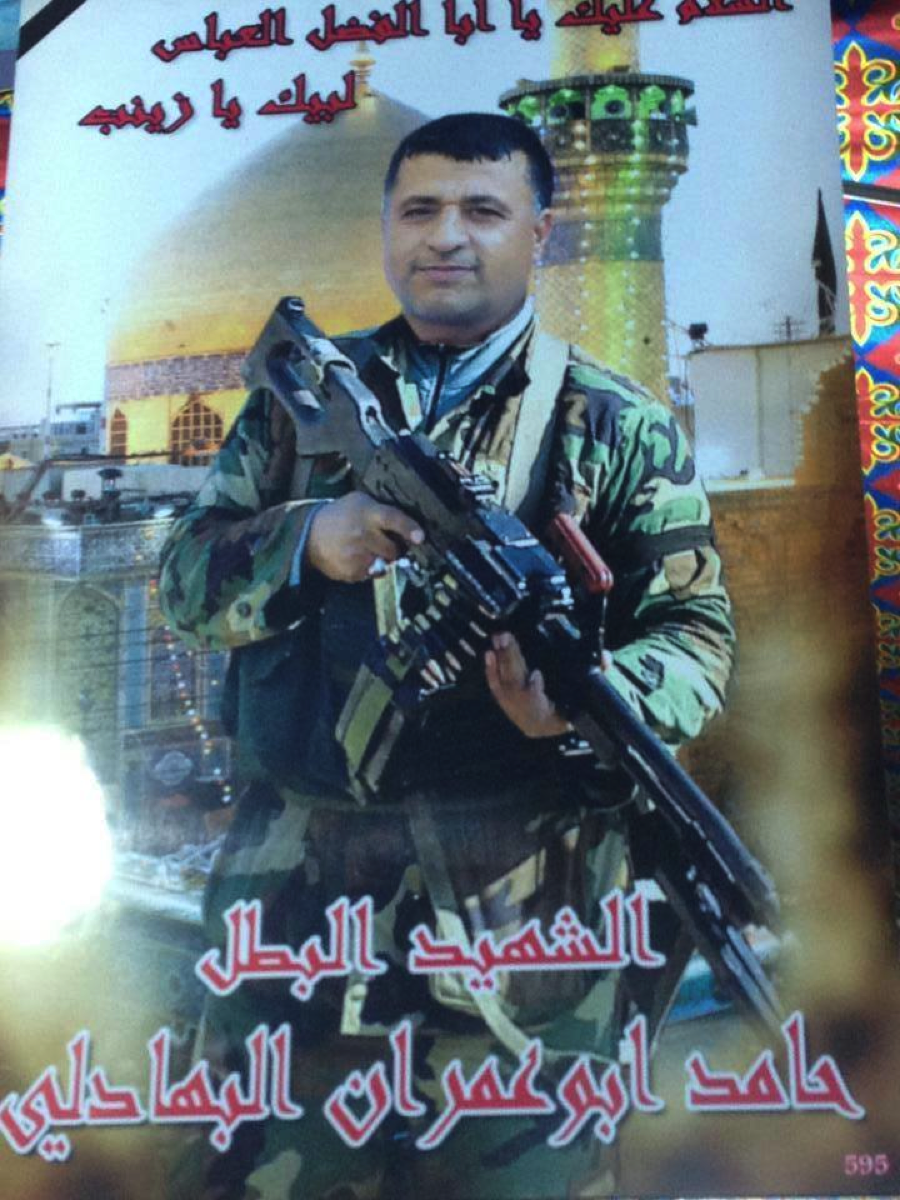
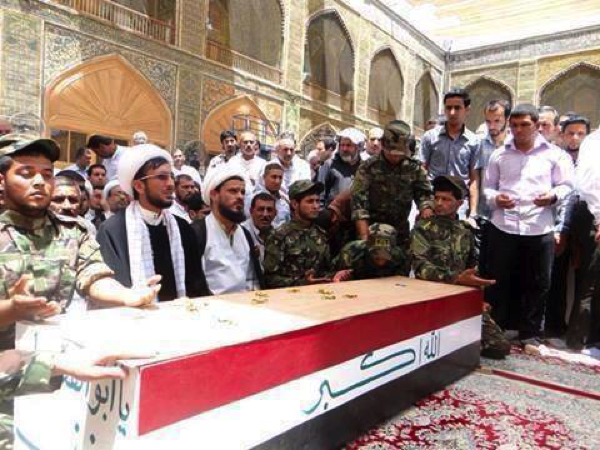
Name: Dergham Hisham al-Sa’di al-Baya (A.K.A. Dergham al-Sa’di)
Affiliated With: Asa’ib Ahl al-Haq/Liwa’a Abu Fadl al-Abbas
Death Announced: May 23, 2013. Funeral was held (in Iraq) on May 24, 2013.
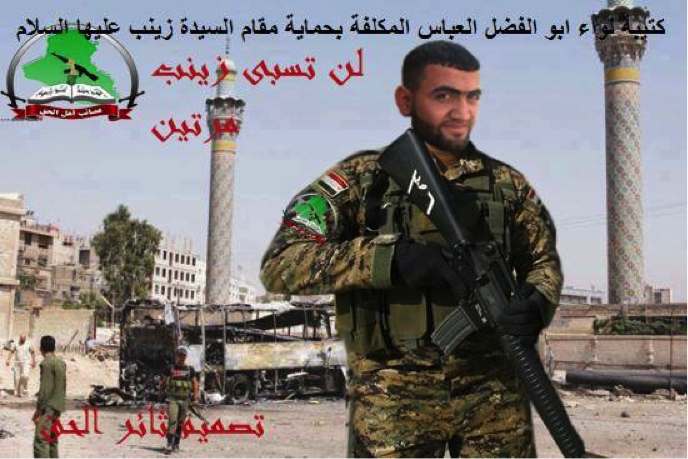
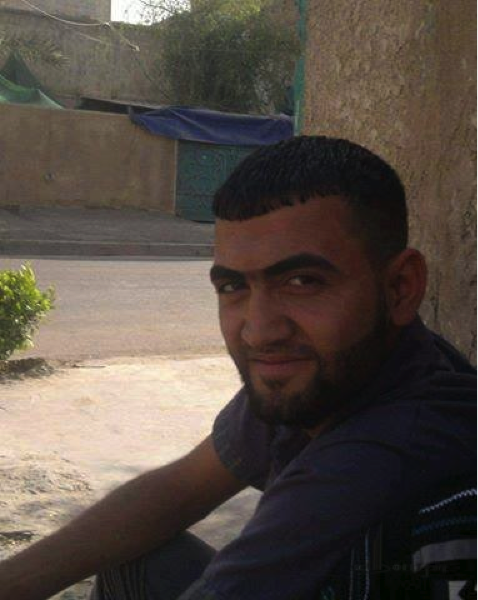
Name: Iyad Fadhl Matar al-Sarifawi
Affiliated With: Asa’ib Ahl al-Haq
Death Announced: May 28, 2013, (reportedly killed on May 26, 2013)
Notes: This is the first Asa’ib Ahl al-Haq martyrdom poster (for a member killed in Syria) to feature Iraq’s late Grand Ayatollah Muhammed Sadiq al-Sadr (left) and Iranian Supreme Leader, Grand Ayatollah Khamenei (right) as bereaved over the loss of a fighter. Al-Sarifawi’s death could only be confirmed on two pro-Hizballah Facebook pages. Since all other Asa’ib Ahl al-Haq members killed in Syria have also fought under the banner of Liwa’a Abu Fadl al-Abbas, it is probable that Sarifawi fought as a member of that organization. However, any affiliation with LAFA has not been publicized.
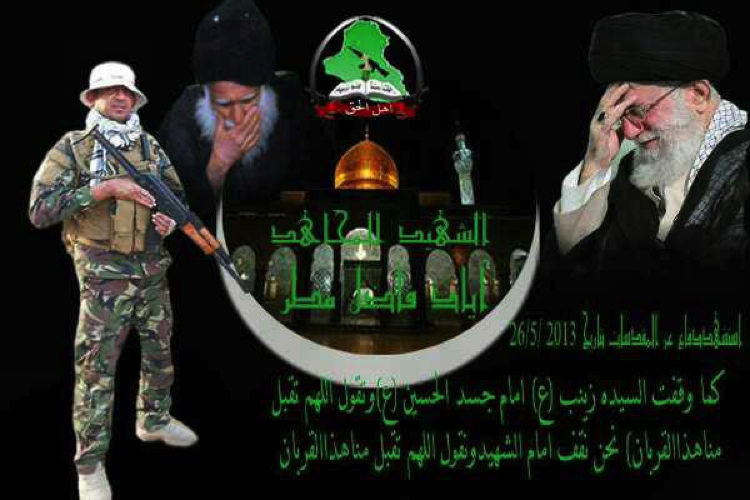
Name: Haidar Jabari Salman al-Jazari
Affiliated With: Kata’ib Sayyid al-Shuhada/Liwa’a Abu Fadl al-Abbas
Death Announced: May 24, 2013 (via YouTube video posting). Funeral was held in Basra, Iraq on May 23, 2013.
Notes: In the video for Jazari, it is claimed he was a “Commander” for the “Sacred defense” of the Zaynab Shrine in Damascus. Jazari’s claimed affiliation with Kata’ib Sayyid al-Shuhada (on his martyrdom poster) is another important facet of his background. The group was first mentioned in late-April during a funeral for an Iraqi Shia in Basra. Kata’ib Sayyid al-Shuhada may be a new organization used to vector volunteer fighters to fight at the Zaynab Shrine. As with other Iraqi Shia killed in Syria, Liwa’a Abu Fadl al-Abbas also claimed Jazari as a member.
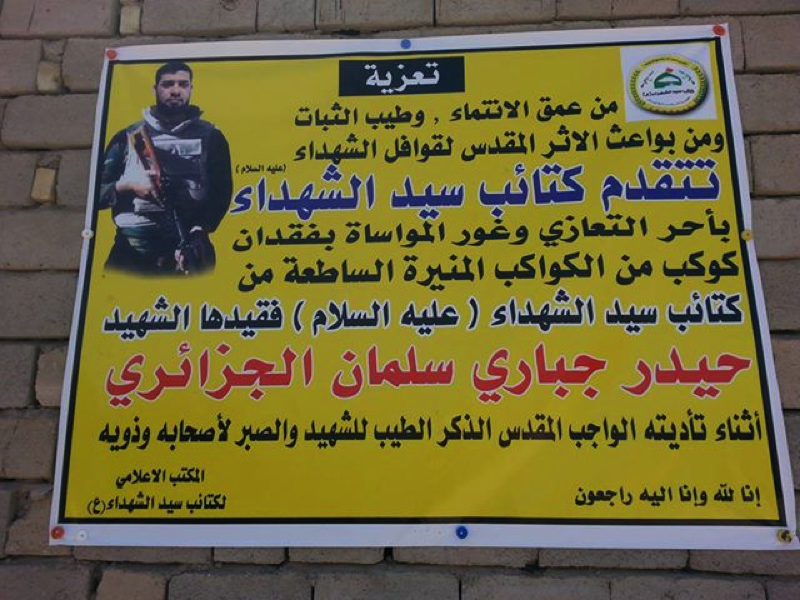
Name: Maytham Khalaf al-‘Aqabi (A.K.A. Ghayth al-‘Asab)
Affiliated With: Asa’ib Ahl al-Haq/Liwa’a Abu Fadl al-Abbas
Death Announced: May 9, 2013
Notes: As with most other killed Asa’ib Ahl al-Haq members, ‘Aqabi’s poster features Iraq’s late Grand Ayatollah Muhammed Sadiq al-Sadr (left) and Iranian Supreme Leader, Grand Ayatollah Khamenei (right). His Iraqi roots were not hidden, with Iraq’s flag and the symbol for Asa’ib Ahl al-Haq pictured between the two ayatollahs.
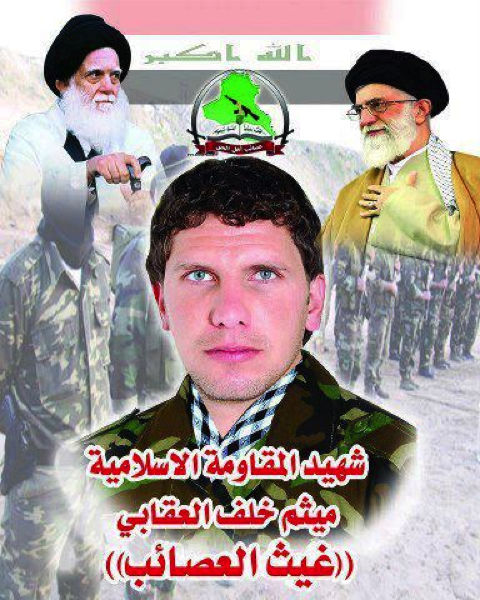 [1] “Hezbollah leader Nasrallah vows victory in Syria”, BBC, May 25, 2013, https://www.bbc.co.uk/news/world-middle-east-22669230.
[2] See: “Analysis Of The History And Growth Of Asa’ib Ahl al-Haq, The League Of The Righteous, An Interview With Institute for the Study of War’s Sam Wyer”, Musings On Iraq Blog, January 7, 2013, https://musingsoniraq.blogspot.com/2013/01/analysis-of-history-and-growth-of-asaib.html
[3] Note: As with Lebanese Hizballah, Iraq’s Kata’ib Hizballah has never officially announced its members were being killed in Syria. Instead, the group claimed its fighters were killed while performing their, “Jihadist duties”.
[1] “Hezbollah leader Nasrallah vows victory in Syria”, BBC, May 25, 2013, https://www.bbc.co.uk/news/world-middle-east-22669230.
[2] See: “Analysis Of The History And Growth Of Asa’ib Ahl al-Haq, The League Of The Righteous, An Interview With Institute for the Study of War’s Sam Wyer”, Musings On Iraq Blog, January 7, 2013, https://musingsoniraq.blogspot.com/2013/01/analysis-of-history-and-growth-of-asaib.html
[3] Note: As with Lebanese Hizballah, Iraq’s Kata’ib Hizballah has never officially announced its members were being killed in Syria. Instead, the group claimed its fighters were killed while performing their, “Jihadist duties”.


